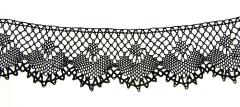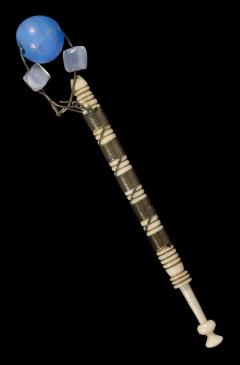ENGLAND: THE OTHER WITHIN
Analysing the English Collections at the Pitt Rivers Museum
Textile technology
Alison Petch,
Researcher 'The Other Within' project
Many of the technologies that were investigated at the Museum were traditionally male in orientation, for example stone tool making. Others were traditionally less gendered, like fire-making, but one or two were traditionally female preserves, like lace-making, spinning and weaving.
1. Lace collections and displays in the Pitt Rivers Museum
Lace-making is not a single technique, it can be seen as a 'blanket term for the visual/material look of the resulting textile'. The museum seems to have been most interested in collecting specimens and tools related to bobbinlace making, but the annual reports do mention lots of different kinds of examples of lace making technologies - tatting, needle lace etc. However, it does seem from the excerpts given below, that they thought of bobbin lace as the most 'English' of
the techniques. [Nicolette Makovicky pers. comm.]
The Museum started collecting lace specimens and lace accessories like bobbins very early on. The first lace making accessories to be accessioned was a collection of bobbins donated by the curator, Henry Balfour in 1895:
[Unknown] Quantity of old lace making bobbins in box, Arncott village Oxon, variously ornamented & very well made. [1895.25.11]
The Museum was always interested in obtaining artefacts and sets of artefacts that showed how lace was actually made, and the different processes that were employed in different areas of England, or elsewhere in the world. For example a large collection of material was obtained from Launton in Oxfordshire (a local textile centre) in 1911. These items were collected and donated by both males and females. Several museum staff and volunteers were interested in lace-making and donated material, including Henry Balfour, G.E.S. Turner, and Beatrice Blackwood. However, the Museum did not include a volume about lace-making in the Occasional Papers on Technology series and none of the Museum staff published on the subject.
In the Annual Report for 1941-2 Tom Penniman, the Curator, reported that 'gifts of tatting and crochet patterns by Mrs. Blackwood and Mrs. Hood; and a collection of lace and lace-makers’ outfit given by Miss Nevell, who has promised to make an exhibition of lace and lace-making from her own gifts and from material we already have'. Very little further is known about Miss Nevell, apart from her first name and initial, Amy J. The next year Penniman reported that Miss Nevell had completed her 'arrangement of an exhibition illustrating the making of Pillow-lace, to which she generously contributed specimens and considerable labour'. [Annual Report 1942-3] Her involvement with the museum continued as the following year he again reported, 'To illustrate European arts and industries, we received small collections, further to illustrate lace-making in England from Miss Nevell and Mr. [G.E.S.] Turner'. [Annual Report 1944-5] She donated more similar material in the following year also. The Museum continued its interest in collecting similar lace making specimens showing manufacture, for example in the Annual Report for 1954-5 it was reported, 'Mr. H.C. Colvin-Smith has added to our collections illustrating the making of pillow-lace a Northamptonshire lacemaker's pillow, with a pattern being worked, bobbins, parchment patterns, thread, and a lace-maker's lamp. These make a valuable research collection to add to our exhibition of Buckinghamshire lace-making and to apparatus from other parts of England.'. Another mention in 1959-60 of another donation, 'Among donors of European things, we may mention our friend Miss M. Parry Okeden, who gave us examples of needle-point lace, Venetian Point, and pillow-lace from Italy and England, a shawl from Ireland of Carrickmacross type lace,[1] and examples of embroidery from England and from India, the latter showing European influence.' [Annual Report 1959-60]
A total of 2,093 lace related specimens from all over the world are held by the Pitt Rivers Museum. Of these a total of 1,865 lace making related artefacts were donated to the Museum from England including complete lace pillows, separate patterns, bobbins etc, lace accessories like lights, and specimens of lace.
Areas of England and different lace-making technologies
Specimens of lace and lace accessories were collected from the following counties:
Bedfordshire - 4 artefacts
Buckinghamshire - 1,016
Buckinghamshire or Oxfordshire - 42
Devon - 42
Essex - 8
Gloucestershire - 4
London - 1
Norfolk - 14
Northamptonshire - 192
Oxfordshire - 369
Somerset - 79
The remainder are not provenanced to a specific county.
The two most important counties represented in the lace collections are Buckinghamshire and Oxfordshire, both very local to the Museum.
Oxfordshire
Oxfordshire lace specimens came from
Arncott - 100? [Note that the number of items in this collection is unknown, see introduction to section above]
Banbury - 44
Bicester - 8
Fritwell - 117
Launton - 51
Marcham - 1
Oxford - 46 [NB the entries for these are not very specific, they may come from elsewhere]
Other Oxfordshire lace related artefacts do not give a specific place of origin.
According to http://www.british-history.ac.uk/report.aspx?compid=63732 in Fritwell 'Lace-making was a considerable home industry and several lacemakers were recorded in the 1851 census. [H.O. 107/1729.][the information is based on Victoria County History: A History of the County of Oxford: Volume 6 Mary D. Lobel (editor) 1959].
Launton
See here for more information.
Buckinghamshire lace specimens come from
Aylesbury - 1
Castlethorpe - 1
Claydon - 1
Hoggeston - 226
Lacey Green - 1
Long Crendon - 1
Marsh Gibbon - 2
Milton Keynes - 33
Shenley - 1
Thornborough - 1
Other Buckinghamshire lace related artefacts do not give a specific place of origin.
Find out more about some of the lace bobbins in the PRM collections
Find out more about some of the lace in the PRM collections
2. Spinning
The museum has quite a few tools used for spinning, ranging from wheels, small neatly made lady's spinning-wheel for wearing in the belt, combs used to prepare wool for spinning etc. The interest that was taken in the general process as well as the artefact can be taken from the latter example:
1902.59.1-2 Pair of hand wool-combs with iron pivot. Now obsolete for about 50 years. Used formerly for preparation of long-stapled wool for spinning the finer qualities of Worsted. Wellington, Somerset. For details of use etc. see letter from Mr. Elworthy
Handwritten letter from Elworthy to Balfour, dated 10 November 1902: '... The modus operandi with the combs now sent was this - The wool comber actually worked at home, and the articles herewith were the outfit but by the master. The comber had to supply himself with a charcoal stove, usually home made of bricks or clay, with slits around the top for the insertion of the comb, leaving the handle & horn part outside. This stove was called "the comb-pot" for heat and damp and oil are all necessary for wool-combing. A strong post is fixed near the comb-pot, into which the iron herewith, called 'a pad' is screwed so that the point at the end is upright. The height is determined by the stature of the workman - say 4.6 to 5 feet from the ground. One comb is then placed on the pad, and in this position the teeth lie horizontally to the right, unless the comber is left handed when his combs have to be made accordingly. The wool having been previously straightened by hand is then dashed on to the comb ( pulled out by hand until sufficient for 2 slivers remaining in it). This is called "filling the comb". Then the other comb at the proper heat is held in the two hands and dragged through the wool in the fixed comb. at the same time the wool drawn out is worked on to the horizontal comb, by drawing that in the hands from right to left so that there is a mutual combing by both. This process is continued by changing the combs from hands to post until the wool is sufficiently straightened. It is then drawn out by the hands into what is called "a sliver" i.e. a band of wool some 8 or 9 feet long. By this process all the long wool is obtained, while a small quantity of short refuse wool is left in the comb. The refuse is called the "noil". "Noils" are well known article of trade, and are used for spinning by carding machinery. This process is repeated ad infinitum each man working with two pairs of combs so that one pair may be heating while the others are in use. It is of interest to know that each tooth is called a "broach". A certain number of "slivers" about 25 lbs [possibly 28 -the writing is difficult to make out] in weight when done up in bundles and bound with bands of combed wool is a "top". ...'
Pitt Rivers Museum artefacts are never 'used' in practical displays today. They can be studied closely, handled with care and whilst wearing gloves, under supervision of museum staff etc as is common to most museum collections in the UK, but in the past things were different. Two entries show how, in the not too distant past, objects could travel and be used:
1949.2.51 - 1949.2.52 MRS B. HOATHER. TEXTILE DEPARTMENT, BROMLEY SCHOOL OF ART, TWEEDY ROAD, BROMLEY , KENT. Photographs taken at the School of Art during the making of a film of spinning methods, for educational purposes. Dec. 1948. - WEST AFRICA, ASHANTI. Five photographs of an AKAN girl, student at the School, spinning in the ASHANTI method, with the spindle resting in a bowl. and Four photographs of a DALMATIAN woman, dressed in the costume of a young widow, spinning with a DALMATIAN distaff borrowed from the Pitt Rivers Museum (P.R. coll. 168/12099).[1884.10.4.4]
This would not be possible today. This visit was described in the Annual Report for 1948-9:
Among its many services for students outside the University the Museum received Miss Barbara Hoather, Head of the Weaving Department of the Bromley College of Art, and her colleague Miss Mitchell, with eight of their students, for about a fortnight, during which they worked on textiles selected by Miss Blackwood, from many parts of the world, and used our publication of the McDougall Collection as a text-book, with the examples before them.
3. Weaving and looms
The Museum has many examples of different forms of looms (or loom parts) from all over the world (522 in total). Approximately a tenth of these are of artefacts from England including models, handlooms, shuttles etc. The museum has even owned some industrial carpet weaving machines, like 1899.49.1 'Hand-loom shuttle formerly used at Wilton Carpet factory in making "Axminster" carpets. sent through H. Gray to J.W. Ward' and 1941.7.3 'D and B Gladding, Kenbury Works, Kenbury St, Camberwell, London S.E. 5 - Hand-weaving carpet loom, wooden frame, in family for over a century, with warp etc for demonstration Both are English £10'
4. Plush
The Museum has a collection of plush-making tools, samples and related artefacts from Shutford which will hopefully be discussed by Nicolette Makovicky before the end of this project on this site.
Find out more about Lace Techniques here.
Acknowledgements
My thanks to Nicolette Makovicky for her helpful comments on this page.
Notes
[1] Carrickmacross lace is not really lace in the conventional sense, but actually white embroidery on net - so unlike
bobbin lace or needle lace, it is not a textile which is 'built up' by the maker using thread [Nicolette Makovicky, pers. comm.]

